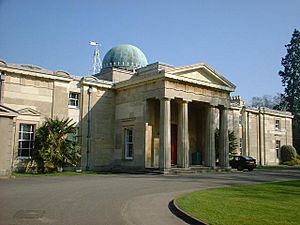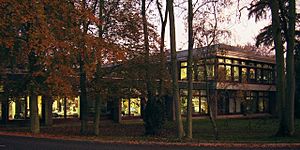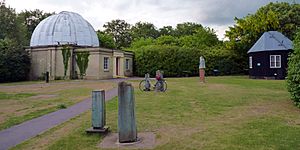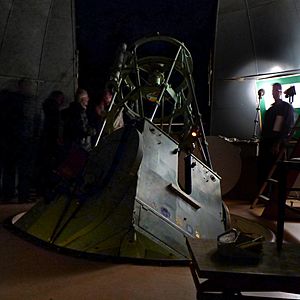Institute of Astronomy, Cambridge facts for kids
 |
|
| Established | 1972 |
|---|---|
| Director | Cathie Clarke and Mark Wyatt |
| Faculty | School of Physical Sciences, University of Cambridge |
| Staff | 177 |
| Location | |
| Address | Madingley Road |
| Website | www.ast.cam.ac.uk |
The Institute of Astronomy (often called IoA) is a big place in the University of Cambridge where people study space. It's one of the largest astronomy centers in the United Kingdom. About 180 scientists, researchers, and staff work here. They all help us learn more about the universe.
Scientists at the IoA study many exciting things. They look at exoplanets (planets outside our solar system) and different types of stars. They also explore cosmology, which is the study of how the universe began and how it changes. Other topics include gravitational-wave astronomy and distant galaxies. They use telescopes to observe space and powerful computers to create models.
The Kavli Institute for Cosmology is also found on the IoA site. This institute focuses on the very early universe. The Cavendish Astrophysics Group also has a building nearby.
Contents
History of the Institute
The Institute of Astronomy was created in 1972. It was formed by joining three older groups:
- The University Observatory: This was started in 1823. Its old building now holds offices and the main library.
- The Solar Physics Observatory: This group began in Cambridge in 1912. Part of its building was taken down in 2008. This made space for the Kavli Institute for Cosmology.
- The Institute of Theoretical Astronomy: Fred Hoyle created this in 1967. Its building is now the main part of the IoA. It has a lecture hall and another wing added later.
From 1990 to 1998, the Royal Greenwich Observatory was also in Cambridge. It was right next to the Institute of Astronomy.
Learning About Space
The IoA teaches university students who are in their third and fourth years. These students learn about many topics in astronomy. They can study things like General Relativity, Cosmology, and Black Holes. They also learn about Extrasolar Planets and how stars form.
Each year, about 12 to 18 students come to the IoA to work on their PhD degrees. These are advanced research degrees. What's special is that students can choose their own research guide. This choice can be made even after they start their studies.
Amazing Scientists at IoA
Here are some of the well-known scientists who work at the Institute of Astronomy now:
- Cathie Clarke
- Carolin Crawford
- George Efstathiou
- Andrew Fabian
- Gerry Gilmore
- Douglas Gough
- Paul Hewett
- Mike Irwin
- Nikku Madhusudhan
- Richard McMahon
- Max Pettini
- James E. Pringle
- Martin Rees
- Christopher Reynolds (who holds a special title called Plumian Professor of Astronomy)
- Christopher Tout
- Anna Zytkow
Famous Scientists From the Past
Many famous scientists have been part of the IoA or its older groups. Here are a few of them:
- Suzanne Aigrain
- George Airy
- Robert Stawell Ball
- James Challis
- John Couch Adams
- Donald Clayton
- Arthur Eddington
- Richard Ellis
- Roger Griffin
- Stephen Hawking
- Fred Hoyle
- Jamal Nazrul Islam
- Harold Jeffreys
- Robert Kennicutt
- Donald Lynden-Bell
- Jayant Narlikar
- Jeremiah Ostriker
- Robert Woodhouse
Telescopes at the Institute
The Institute of Astronomy has several telescopes on its grounds. While some are used for science, most are for public viewing. They are also used by astronomy clubs. The weather in Cambridge often makes it hard to do advanced astronomy.
Here are some of the telescopes you can find there:
- The Northumberland Telescope: This telescope was given by the Duke of Northumberland in 1833. It has a lens that is about 300 mm (12 inches) wide.
- The Thorrowgood Telescope: This is a smaller telescope, about 200 mm (8 inches) wide. It is on loan from the Royal Astronomical Society.
- The 36-inch Telescope: This large telescope was built in 1951.
- The Three-Mirror Telescope: This is a special test telescope. It has a unique design to show wide, clear images.
The institute used to have a 24-inch Schmidt Camera. It was given to the Spaceguard Centre in Wales in 2009.
Two local astronomy groups, the Cambridge University Astronomical Society (CUAS) and Cambridge Astronomical Association (CAA), often use these telescopes. The Institute also has public viewing nights on Wednesdays from October to March.
Public Events and Activities
The Institute of Astronomy hosts many events for the public. These events help people learn more about space. Some of these activities include:
- Open Evenings: On Wednesdays during winter, there are talks by scientists. If the sky is clear, people can look through the telescopes.
- Astroblast Conference: The institute has hosted this event.
- Sculpture Exhibition: An annual show of art from Anglia Ruskin University.
- Open Day: This happens every year during the Cambridge Science Festival.
- Astropod Podcast: This is a monthly podcast for everyone interested in space. It started in 2009 and came back in 2020.
- Special Observing Nights: Extra nights are held for big events like IYA Moonwatch and BBC Stargazing Live.
The IoA Library
The library at the Institute is in the old Cambridge Observatory building. It is a special library focused on astronomy and space science. It has about 17,000 books and many science magazines. The library also has a rare collection of old astronomy books. Many of these books belonged to the famous astronomer John Couch Adams.
Important Discoveries
The Institute of Astronomy has made many important contributions to astronomy. One big achievement was using the Automatic Plate Measuring (APM) machine. This machine helped create a huge list of objects in the northern sky.





